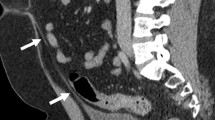Abstract
Purpose
Anatomical surface landmarks are frequently used by clinicians to guide both diagnosis and treatment. Few studies have examined the reliability of vascular anatomical landmarks in living subjects. The umbilicus has traditionally been described as a surface landmark for the bifurcation of the abdominal aorta. This study examined the factors affecting the position of the umbilicus relative to that of the aortic bifurcation in 95 patients.
Methods
106 consecutive abdominal CT scans were analysed by a surgeon and radiologist. Following exclusion of CT scans with relevant significant intra-abdominal pathology, 95 patients were included in the study. Measurements were taken of the craniocaudal distance between the aortic bifurcation and umbilicus, as well as maximum subcutaneous fat thickness at the level of the umbilicus. Patient age and gender were also documented.
Results
The umbilicus was found to lie −6.3 ± 26.5 mm from the aortic bifurcation. Increasing subcutaneous fat thickness was associated with a more caudal position of the umbilicus relative to the aortic bifurcation. This result was highly statistically significant in males over 65 years old.
Conclusions
This study suggests that the umbilicus is a reliable clinical surface landmark for the bifurcation of the abdominal aorta. Whilst some variation in craniocaudal distance exists between patients, in the majority of cases, the bifurcation of the abdominal aorta lies within a clinically narrow range of distances from the umbilicus.


Similar content being viewed by others
References
Al-Talib A, Alharbi F, Valenti D, Tulandi T (2010) Location of aortic bifurcation and transverse colon in postmenopausal women: relevance to laparoscopy. Surg Technol Int 19:130–134
Alharbi F, Al-Talib A, Valenti D, Reinhold C, Meterissian S, Tulandi T (2010) Anatomic relation between the umbilicus, aortic bifurcation, and transverse colon in males. Surg Technol Int 220:124–127
Chithriki M, Jaibaji M, Steele RD (2002) The anatomical relationship of the aortic bifurcation to the lumbar vertebrae: a MRI study. Surg Radiol Anat 24(5):308–312
Good MM, Abele TA, Balgobin S, Montoya TI, McIntire D, Corton MM (2013) Vascular and ureteral anatomy relative to the midsacral promontory. Am J Obstet Gynecol 208(6):486
Hale SJ, Mirjalili SA, Stringer MD (2010) Inconsistencies in surface anatomy: the need for an evidence-based reappraisal. Clin Anat 23(8):922–930
Hurd WW, Bude RO, DeLancey JO, Pearl ML (1992) The relationship of the umbilicus to the aortic bifurcation: implications for laparoscopic technique. Obstet Gynecol 80(1):48–51
Jeong JY, Kim YR, Kim JY, Jee BC, Kim SH (2014) Vertical distance between umbilicus to aortic bifurcation on coronal view in Korean women. Obstet Gynecol Sci. 57(1):44–49
Khamanarong K, Sae-Jung S, Supa-Adirek C, Teerakul S, Prachaney P (2009) Aortic bifurcation: a cadaveric study of its relationship to the spine. J Med Assoc Thai 92:47–49
Lakchayapakorn K, Siriprakarn Y (2008) Anatomical variations of the position of the aortic bifurcation, iliocava junction and iliac veins in relation to the lumbar vertebra. J Med Assoc Thai 91:1564–1570
Lee CH, Seo BK, Choi YC, Shin HJ, Park JH, Jeon HJ, Kim KA, Park CM, Kim BH (2004) Using MRI to evaluate anatomic significance of aortic bifurcation, right renal artery, and conus medullaris when locating lumbar vertebral segments. AJR Am J Roentgenol 182(5):1295–1300
Mirjalili SA, McFadden SL, Buckenham T, Stringer MD (2012) A reappraisal of adult abdominal surface anatomy. Clin Anat 25(7):844–850
Nezhat F, Brill AI, Nezhat CH, Nezhat A, Seidman DS, Nezhat C (1998) Laparoscopic appraisal of the anatomic relationship of the umbilicus to the aortic bifurcation. J Am Assoc Gynecol Laparosc 5(2):135–140
Power ML, Schulkin J (2008) Sex differences in fat storage, fat metabolism, and the health risks from obesity: possible evolutionary origins. Br J Nutr 99:931–940
Conflict of interest
The authors report no conflict of interest. The authors alone are responsible for the content and writing of the paper.
Author information
Authors and Affiliations
Corresponding author
Rights and permissions
About this article
Cite this article
Attwell, L., Rosen, S., Upadhyay, B. et al. The umbilicus: a reliable surface landmark for the aortic bifurcation?. Surg Radiol Anat 37, 1239–1242 (2015). https://doi.org/10.1007/s00276-015-1500-1
Received:
Accepted:
Published:
Issue Date:
DOI: https://doi.org/10.1007/s00276-015-1500-1




